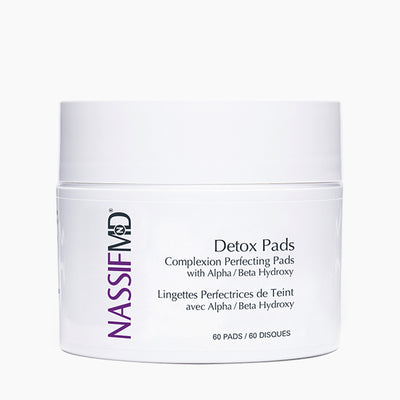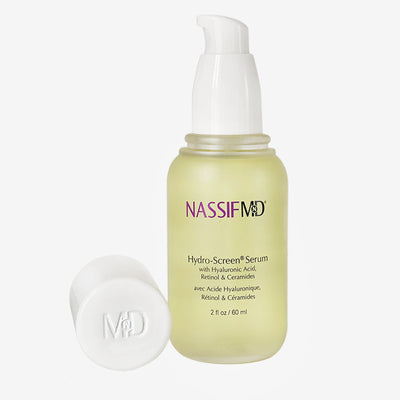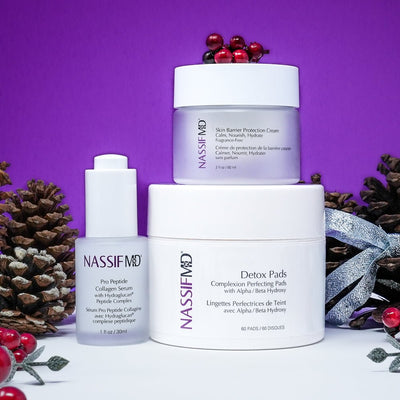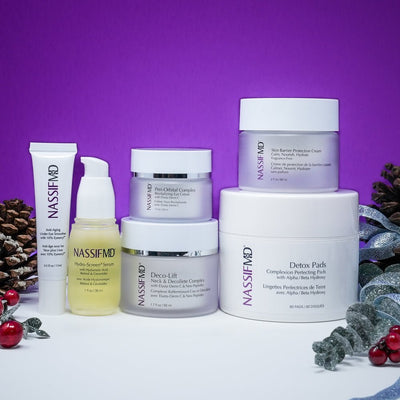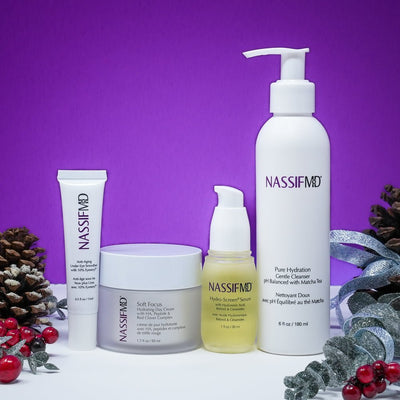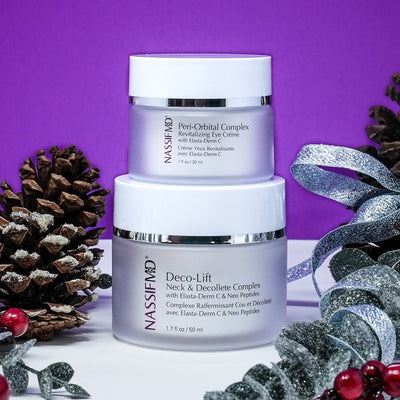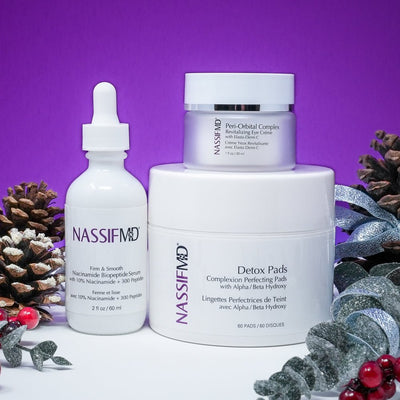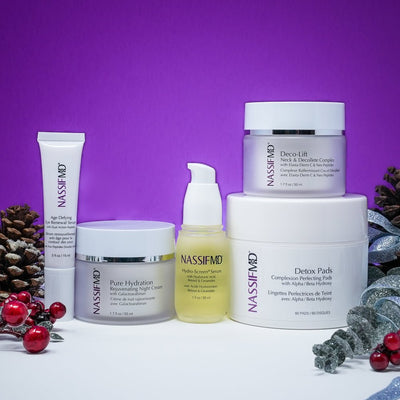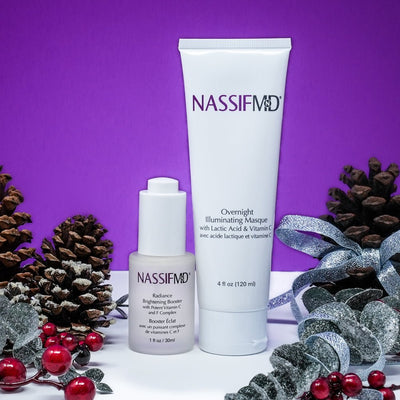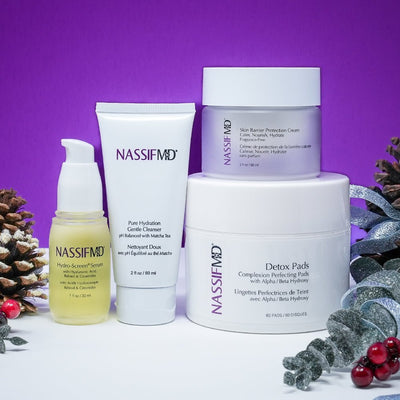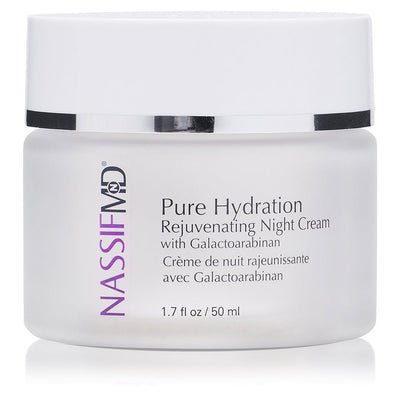Understanding the Basics of Cleansing, Toning, and Moisturizing
Your skin provides a barrier between you and the outside world, and with all the stress and pollution of daily life, it can take a beating. A simple cleansing, toning, and moisturizing routine (CTM routine, if you will) is your insurance policy against clogged pores, acne, and skin aging.
All you need is a few minutes in the morning and evening and quality NassifMD® facial plastic surgeon skincare.
Of course, you can have a more intricate skincare routine, but let’s start with the foundations: cleanse, tone, moisturize.
Keep reading as we dive into:
- The ins and outs of cleansing, toning, and moisturizing
- Skincare cleanser – what you need to know
- Toning for skin health
- Skin moisturizers and best practices
- The best skin cleanser and toner
What’s the difference between a cleanser and toner? Or toner vs. moisturizer? Let’s jump in!
What Are the Steps of Cleansing, Toning, and Moisturizing?
For the cleanse tone moisturize (CTM) skincare routine, you need three products with specific purposes: cleansing, toning, and moisturizing.
Cleansing removes dirt, makeup, excess oil, toxins, and other impurities from your skin. It supports skin regeneration and overall health. It should be the first step of every skincare routine, creating a clean slate for the next steps.
Toning helps calm the skin after cleansing and restores the skin’s pH, preparing the skin for the next steps in the skincare routine. Toning can also aid in skin hydration. Of the three steps listed here, some people skip toning, but we recommend it.
After cleansing and toning, the pores are open, and the skin is clean. You can apply other skincare steps or jump right to moisturizing. Moisturizing supports skin barrier health, skin hydration, texture, and tone. It locks in skincare ingredients and prevents water loss.
What Does Cleansing, Toning, and Moisturizing Do?
CTM is the foundation of your morning and evening skincare routine. Beyond skincare, this three-step process becomes a ritual and a meaningful way to practice self-care.
Overall, cleansing, toning, and moisturizing supports skin health, hygiene, and appearance. You can’t skip these steps if you want healthy, radiant skin.
In What Order Do I Use Cleanser, Toner, and Moisturizer?
Use products in this order: cleanser, toner, and moisturizer. If you use other products in your skincare routine, such as face serums, put them between toning and moisturizing. Then, sunscreen goes on last in your morning routine.
Please read Order of Application: Step-By-Step Skin Routines for more instructions.
Skincare Cleanser
Cleansers lower the surface tension on the skin and act as an emulsifier (like soap) to aid in the removal of dirt, excess oils, and other debris that accumulates on the skin. It should always be the first step of your skincare routine, morning and night.
Purpose: Remove Dirt and Oil
The primary purpose of a skin cleanser is cleansing, but research suggests the benefits also include:
- Social and cultural aspects
- Mood and well-being
- Aesthetics
- Biological necessity
Types: Gels, Foams, Oil-Based, and Creams
The first skin cleanser was soap, which could disrupt the skin barrier and change the skin’s pH to be more alkaline. (Note: the skin’s natural state is acidic). Newer cleanser formulations are much less harsh and can be a gel, foam, oil, or cream.
Some cleansers also contain exfoliators, like glycolic acid, to gently removing dead skin cells and clearing pores. When you choose a cleanser plus exfoliator, you can save a skincare step.
If you only exfoliate occasionally, you may want a separate exfoliating product. In that case, the skincare order would be: cleanse, exfoliate, tone, and then moisturize.
Effective Cleanser Tips
With any cleanser, dampen the face with warm water, apply the cleanser gently, rubbing all areas, rinse off with warm water, and pat dry.
Always use a quality cleanser that matches your skin type. You don’t want to strip away too much of your skin’s natural oils, nor do you want to choose a product that isn’t effective enough for your needs.
Choose from the NassifMD® line of quality, medical spa-grade cleansers:
- NassifMD® Dawn to Dusk AM + PM – Exfoliate, cleanse, and protect the skin with this dual-action gel-to-foam cleanser designed for twice-daily use.
- NassifMD® Pure Hydration Facial Cleanser – Refresh, brighten, and soften the skin with this gentle emollient cleanser while infusing it with hydration and antioxidants.
- NassifMD® Purifying Glycolic Facial Cleanser – Cleanse, brighten, and smooth the skin with this 2-in-1 cleanser-exfoliator to deeply clean and nourish the skin.
- NassifMD® Detox Facial Pads – One of our best-selling products, this unique combination of deep cleansing and exfoliation can be used after cleansing or on its own to brighten and prep the skin for the next steps in your skincare routine.
Toning for Skin
Toning is not as intuitive as cleansing and moisturizing. Let’s answer a few FAQs:
Q: What is the meaning of toning the skin?
A: Toning is applying a liquid product to the skin after cleansing to continue the cleansing job, balance pH, and prepare the skin for the next steps.
Q: Should I use toner before or after face wash?
A: After. Wash your face first, then apply toner.
Q: Is cleanser and moisturizer enough?
A: Some people get away with only cleansing and moisturizing, but you may want to consider some of the important benefits of toning, which we’ll discuss next. In short, try using a cleanser, toner, and moisturizer.
Purpose: Balance pH and Remove Residue
The skin’s pH affects the microbiome, the collection of microorganisms living on the skin that play important roles in its health, appearance, and balance.
The natural, preferable skin pH is more acidic, but cleansing can shift the skin to a higher pH (more alkaline). Toning brings the pH back down into a more acidic range.
Types: Hydrating, Exfoliant, and Astringent
Astringent ingredients, like alcohol, aren’t used much in toners anymore because they can be harsh and stripping. Exfoliating toners, as another category, contain exfoliants, like hydroxy acids, and may be better suited for oily or acne-prone skin.
The most effective toners are hydrating, pH balancing, and gentle.
Effective Toner Application Tips
Spray toner on a damp face immediately after cleansing. Alternatively, you can apply a toner with a cotton ball by swiping the face upwards and outwards.
NassifMD® Skincare offers two toner options to support all skin types:
- NassifMD® 3HA Hydrating Facial Mist – Quench, prep, and refresh the skin with this ultra-hydrating toner containing three forms of hyaluronic acid. Use it twice daily as a toner or spay a mist whenever your skin needs a refresh.
- NassifMD® Pure Hydration Replenishing Toner – Balance, hydrate, and calm the skin with this refreshing toner with hyaluronic acid and moisturizing ingredients.
Skin Moisturizers
Disruption of the skin barrier plays a role in aging, dry skin, and various skin conditions.
A quality moisturizer is one of the most effective tools for supporting healthy skin barrier function.
Always close out your skincare routine with a quality moisturizer. Note that you may need to adjust your moisturizer to the season, using lightweight products in warmer months and thicker ones in winter.
Please note: when you use skincare serums, apply them after cleansing and toning and before moisturizing.
Purpose: Hydrate and Protect the Skin
Moisturizers contain oils and occlusive ingredients that form a barrier on the outer layer of skin. This locks in moisture and the products used earlier in your skincare routine, while preventing water evaporation. It essentially creates a seal or barrier that protects the skin. You’ll find moisturizers designed for all skin types and needs, including:
- Moisturizer for dry skin
- Moisturizer for sensitive skin
- Moisturizer for oily skin
Types: Gels, Lotions, Creams, and Oils
Moisturizers are typically lotions or creams but could also be gels or oils. Oil-based creams may provide the best hydrating and moisturizing properties if your skin is dry. If you have oily or combination skin, you may prefer a water-based formula. Either way, NassifMD® Skincare has you covered!
Moisturizing Best Practices
Apply a small amount of moisturizer as the last step of your skincare routine at night. In the morning, follow your moisturizer with SPF protection. You can use a different moisturizer morning and night or the same one to streamline your routine.
The NassifMD® line of moisturizers includes:
- NassifMD® Soft Focus Hydrating Day Cream – Plump, glow, and instantly perfect the skin with this creamy, quickly absorbent daytime formula that doubles as a makeup primer.
- NassifMD® Pure Hydration Night Cream – Plump, repair, and deeply hydrate the skin overnight with this nighttime formula so you wake up dewy and fresh.
- NassifMD® Hydro-Screen Souffle – Hydrate, nourish, and plump the skin with this face and body moisturizing souffle (a lightweight water-based cream that goes on silky smooth) to improve firmness, tone, and radiance.
For healthy skin, start with a skin cleanser, toner, and moisturizer. With just three products, you can transform your skin and create a skincare ritual that will serve you in the decades to come.
References
- Blaak, J., Grabmann, S., Simon, I., Callaghan, T., & Staib, P. (2023). Five dimensions of cleansing: A holistic view on the facets and importance of skin cleansing.International journal of cosmetic science, 45(5), 557–571.
- Mijaljica, D., Spada, F., & Harrison, I. P. (2022). Skin Cleansing without or with Compromise: Soaps and Syndets.Molecules (Basel, Switzerland), 27(6), 2010.
- Smythe, P., & Wilkinson, H. N. (2023). The Skin Microbiome: Current Landscape and Future Opportunities.International journal of molecular sciences, 24(4), 3950.


